#Thought processes
Text
Some idle speculation about moopsies.
The traits that humans (and presumably humanoid Star Trek aliens) find cute are those associated with infants - small size, stubby limbs, disproportionately large eyes and heads, behaviour that signals a need for protection and nurturing. (Which is the general response individual people have to things they find cute, whether that actually includes babies for them personally or not.) This is broadly true across social mammals, whereas the offspring of species that provide for themselves from birth without a need for a parental bond often lack these traits if they get in the way of how they feed themselves.
Hypothesis 1: Moopsies evolved to invoke this response to attract or distract prey. Kind of boring, but the most obvious explanation. (I'm not sure how viable that is, though - most advantages of looking cute seem to appear on a longer time span, and encouraging their prey to spend a lot of time close to them doesn't seem very relevant to moopsies' apparent strategy as persistence hunters. Maybe they grow up as brood parasites before they become apex predators?)
Hypothesis 2: Moopsies' appearance is a coincidental product of unrelated selection pressures in their native ecosystem - which is full of species (possibly swamp gobblers, for example) whose infants don't look remotely cute by human standards.
Corollary to hypothesis 2: Swamp gobblers react to human babies the same way humans do to the face of a snarling jaguar.
10 notes
·
View notes
Text
"Decoding the Enigma of Human Nature: William Walker Atkinson's Profound Exploration"

In "How to Read Human Nature: Its Inner States and Outer Forms," William Walker Atkinson embarks on an ambitious journey to unravel the intricate mysteries of the human psyche. Published in the early 20th century, Atkinson's work serves as a fascinating amalgamation of psychology, philosophy, and esoteric wisdom, offering readers a comprehensive guide to understanding both the internal workings and external expressions of human nature. The book's title itself hints at the dual focus—inner states and outer forms—that shapes the foundation of Atkinson's exploration.
Atkinson's prose, though rooted in the language of its time, remains remarkably accessible and engaging. The author's skill in elucidating complex psychological concepts is evident as he delves into the nuances of human behavior, emotions, and thought processes. One of the key strengths of the book lies in Atkinson's ability to bridge the gap between the esoteric and the practical, providing readers with tools to navigate the intricacies of human interactions in their daily lives.
The first part of the book delves into the inner states of human nature, exploring topics such as emotions, desires, and the subconscious mind. Atkinson draws on various psychological theories of his time, blending them with insights from mysticism and metaphysics. His exploration of the impact of thoughts and emotions on one's well-being and interactions reflects a holistic understanding of the human experience.
The second part of the book turns its attention to the outer forms of human nature—physical appearance, body language, and the expressions of personality. Atkinson asserts that external features can offer valuable insights into an individual's character, motivations, and potentialities. While some of the physiognomic theories presented may seem antiquated in the context of contemporary psychology, they offer a glimpse into the historical evolution of ideas surrounding the connection between appearance and character.
Atkinson's work also touches upon the concept of personal magnetism and the power of attraction. He argues that an individual's inner qualities can radiate outward, influencing their external environment and relationships. This exploration aligns with the broader metaphysical currents of the time, emphasizing the interconnectedness of mind, body, and spirit.
Despite the book's age, "How to Read Human Nature" maintains its relevance as a valuable resource for readers interested in the intersections of psychology, philosophy, and spirituality. Atkinson's interdisciplinary approach serves as a bridge between the scientific and the metaphysical, inviting readers to contemplate the intricate dance between internal states and external manifestations in the complex tapestry of human nature.
In conclusion, William Walker Atkinson's "How to Read Human Nature" is a thought-provoking exploration that transcends its historical context. While some aspects may reflect the scientific understanding of its era, the book's enduring value lies in its holistic approach to understanding human nature. It serves as an intriguing testament to the timeless quest to decipher the enigma of the human psyche, offering readers a unique perspective that straddles the realms of science and mysticism.
"How to Read Human Nature: Its Inner States and Outer Forms," by William Walker Atkinson is available in Amazon in paperback 10.99$ and hardcover 18.99$ editions.
Number of pages: 177
Language: English
Rating: 8/10
Link of the book!
Review By: King's Cat
#William Walker Atkinson#How to Read Human Nature#Inner states#Outer forms#20th century psychology#Esoteric wisdom#Comprehensive guide#Dual focus#Human behavior#Emotions#Thought processes#Accessible prose#Psychological concepts#Daily interactions#Subconscious mind#Mysticism#Metaphysics#Holistic understanding#Physiognomic theories#Personal magnetism#Power of attraction#Inner qualities#External environment#Relationships#Interdisciplinary approach#Science and mysticism#Spiritual exploration#Historical context#Thought-provoking#Deciphering human psyche
2 notes
·
View notes
Text
I keep getting stuck in a feedback loop.
"Should I post this thing" "it'll look like you're asking for attention"
But why do I keep worrying about it. Like. Really.
If it really annoys anyone that's following me the unfollow button is right there. I don't need to know about it. I probably don't really know who has unfollowed anyway - it hasn't really BOTHERED me.
So why is it now?
Because I'm screaming into the void. And somewhere along the way I started to forget that. Worrying about annoying the void? The inanimate intangible thing that doesn't even exist?
Maybe it'll annoy some people. I guess that's just how the cookie crumbles. But maybe it's time to stop walking in circles. "Don't post that because it'll be annoying" "don't post that it'll look like you're fishing for comments". Maybe. Maybe not. I need to get back to that space where I'm screaming at the void for me. Not for anyone else to overhear.
Like when I screamed work-in-progress shots to try and convince myself I was making progress. I didn't care about whether people commented, they weren't there for that. It was for me to measure my progress after a certain amount of time and that was it, end of story. If people commented it was a bonus.
So maybe that's what I need to work back towards.
Screaming at the void. And maybe smiling a little inside if it decides to talk back.
1 note
·
View note
Text
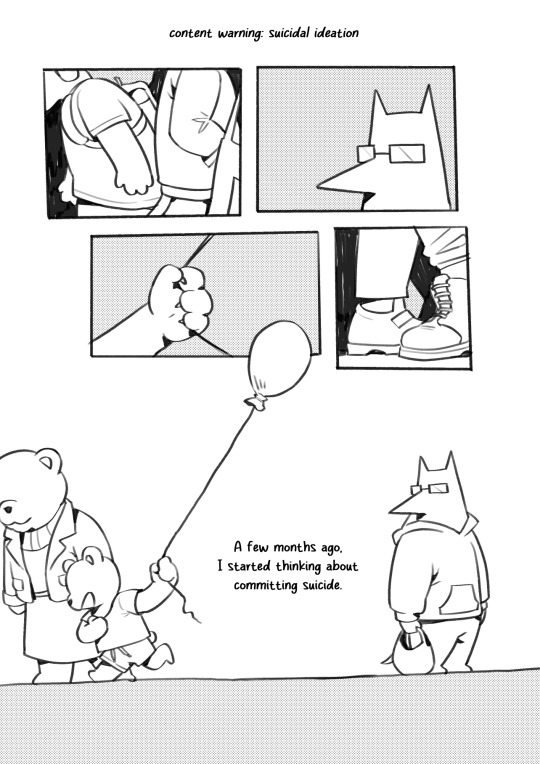

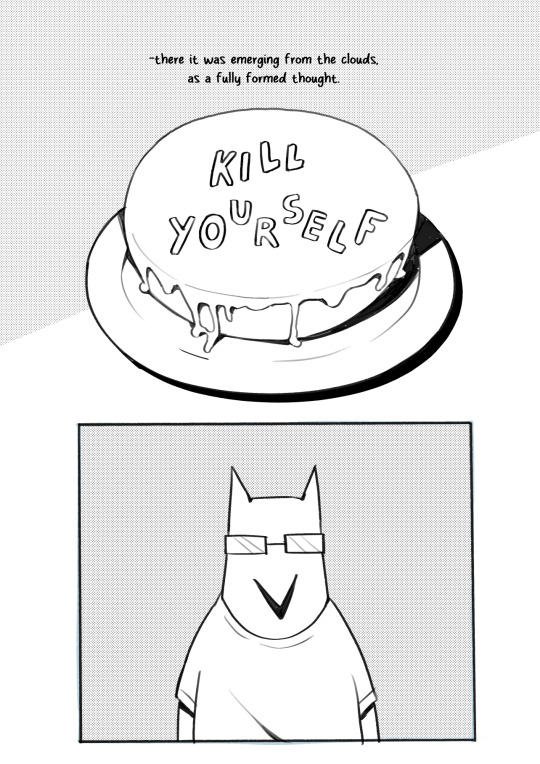
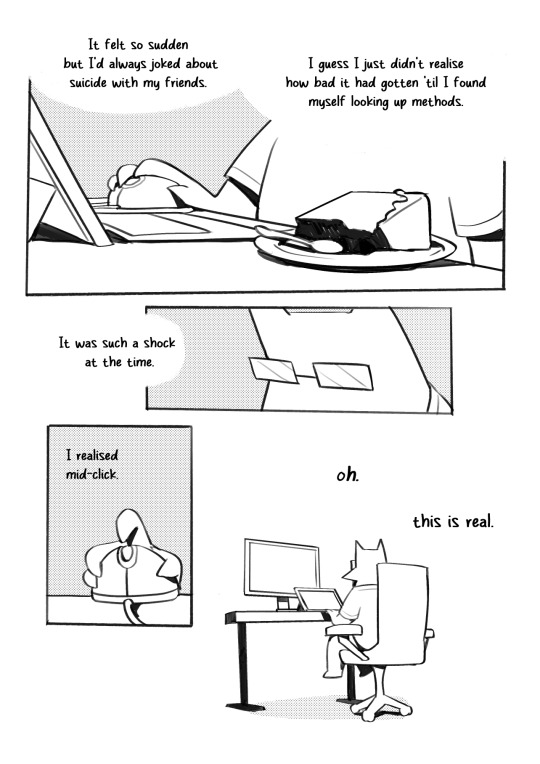
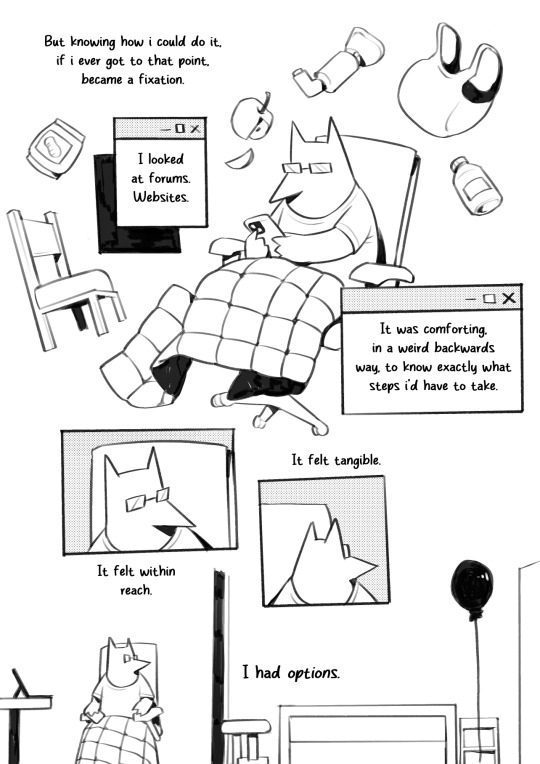
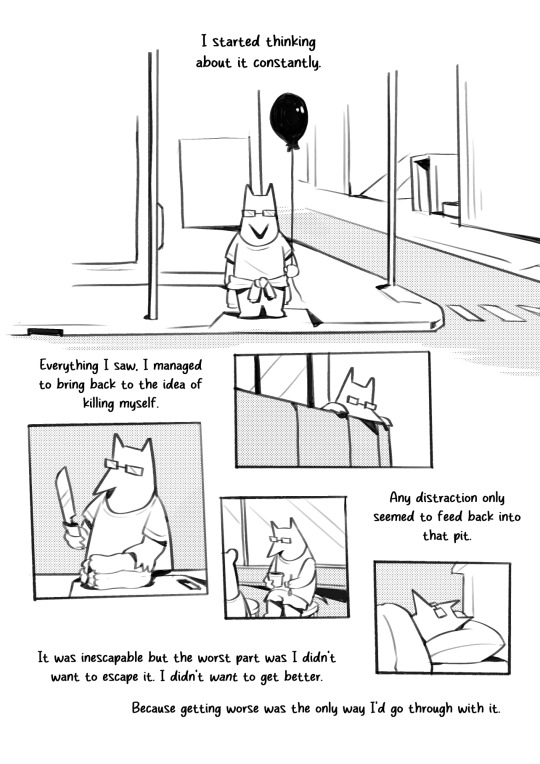
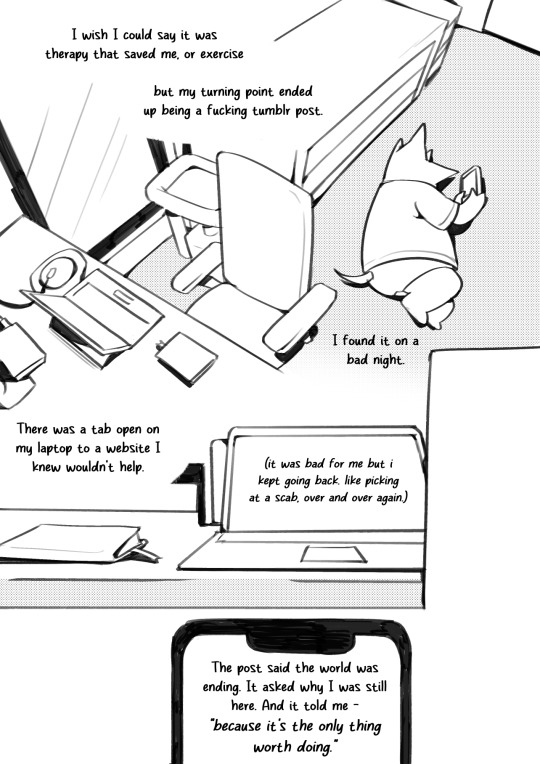





lead balloon (the tumblr post that saved me)
if this comic resonated with you, it would mean the world to me if you donated to this palestinian family's escape fund.
--
no creative notes because this isn't that kind of comic.
I know I don’t owe any of you anything but I still felt compelled to write about my long term absence. And I feel far enough away from the dangerous spot I was in to be able to make this comic. I have a therapist now, and she agreed that making this could be a very cathartic gesture, and the start of properly leaving these thoughts behind me. I am still, at seemingly random times, blindsided by fleeting desires to kill myself. They’re always passing urges, but it’s disarming, and uncomfortable. I worry sometimes that my brain’s spent so long thinking only about suicide that it’s forgotten how to think about anything else. Like, now that I've opened that door for myself, I'll never be able to fully shut it again. But I’m trying my best to encourage my mind in other directions. We'll see how that goes.
I am still donating all proceeds from my store to Palestinian causes. So far, I've donated over $15K, not including donations coming from my own pocket or the fundraising streams which jointly raised around $10K. In the time since I made my initial post about where this money would be going, the focus has shifted from aid organisations to directly donating to escape funds.
If you'd like to do the same, you can look at Operation Olive Branch, which hosts hundreds of Palestinian escape funds or donate to Safebow, which has helped facilitate the safe crossing and securing of important medical procedures for over 150 at-risk palestinians since the beginning of the genocide.
#cw: suicidal ideation#cw: suicide#cw: self harm#cw: mental health#cw: depression#i made the balloon the main representation of my self destructive urges for a reason but im not going to explain it#i tried to keep a lot of the details in this vague#it would be my worst nightmare if this comic encouraged someone to hurt themselves#so. please dont#for a long time even the thought of making this comic felt so insipid and narcissistic#with the state of the world as it is#having the only threat to your life be yourself felt so privileged and trite and shameful#but doing this comic made me sit down and process things in full#and im just. very grateful i didn't give in to my thoughts back when i sincerely felt i'd be more useful to the world dead#i also feel the need to say that this wont represent everyone's battle with mental illness. its unfortunately different for all of us#there is no fix-all#and im afraid this might be one of those comics that either resonates a lot or misses the target by a mile#i made it for myself foremost. and now that its done im glad i did it#thank you for reading#and please stay alive#stillindigo art#stillindigo comics
14K notes
·
View notes
Text

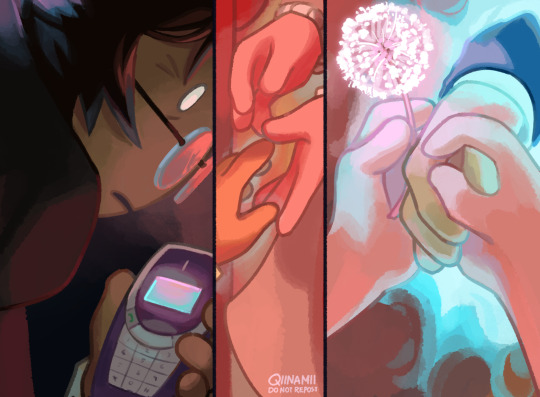

we'll do fine.
#fionna and cake spoilers#what hits me a little is how similar fionna and simon's stories are in the case of finding nuance in their lives#when both have gone through their separate but still valid pain no matter the extent it had been#and its that they met each other they get to see how it compares and they're no less worth of the peace and fun they dreamed of#even in the form of simplicity and just being normal#“i wouldn't have met THE fionna and cake” “we wouldn't have met THE simon petrikov”#it hits me harder that after the dandelion scene would've been their last time seeing each other physically#and how assuring simon sounded when fionna didn't know what to do with the literal world in her hands#tho im sure prismo isnt that much of a rule jerk lol i still drew out the revelation anyway with this tiniest addition#also the fact fionna's world is influenced by simon's thought processes and conditions so now things are a little better for both of them#fionna the human#fionna campbell#simon petrikov#qiiarts#the lil flashback of#betty grof#fionna and cake#adventure time
34K notes
·
View notes
Text

source
#saw those pictures and immediately thought about my writing process#have a shitte meme i guess#writing#fanfiction#ben affleck#5k#8k
20K notes
·
View notes
Text
Unlocking the Mind's Full Potential
A Journey Beyond the OrdinaryIn a world where our thoughts often run on autopilot, dictated by routine and societal norms, the true potential of the human mind remains largely untapped. It’s akin to a vast, unexplored landscape, brimming with possibilities that transcend the mundane. But how do we navigate this inner wilderness and fully express the capabilities of our minds?The first step is…
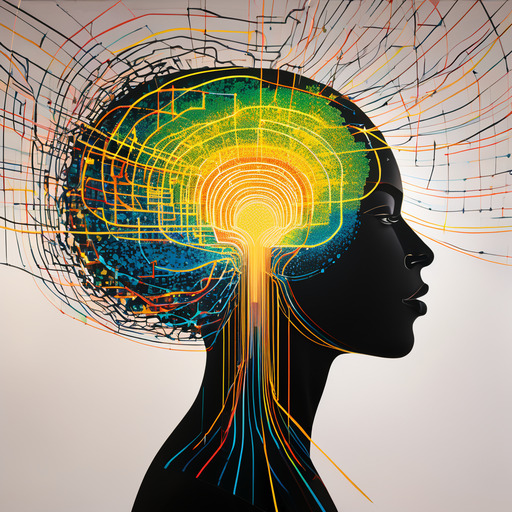
View On WordPress
#Cognitive Development#creativity#Curiosity#Human Potential#innovation#Intellectual Curiosity#mental exploration#mindfulness#Personal Growth#Thought Processes
1 note
·
View note
Text
"Decoding the Enigma of Human Nature: William Walker Atkinson's Profound Exploration"

In "How to Read Human Nature: Its Inner States and Outer Forms," William Walker Atkinson embarks on an ambitious journey to unravel the intricate mysteries of the human psyche. Published in the early 20th century, Atkinson's work serves as a fascinating amalgamation of psychology, philosophy, and esoteric wisdom, offering readers a comprehensive guide to understanding both the internal workings and external expressions of human nature. The book's title itself hints at the dual focus—inner states and outer forms—that shapes the foundation of Atkinson's exploration.
Atkinson's prose, though rooted in the language of its time, remains remarkably accessible and engaging. The author's skill in elucidating complex psychological concepts is evident as he delves into the nuances of human behavior, emotions, and thought processes. One of the key strengths of the book lies in Atkinson's ability to bridge the gap between the esoteric and the practical, providing readers with tools to navigate the intricacies of human interactions in their daily lives.
The first part of the book delves into the inner states of human nature, exploring topics such as emotions, desires, and the subconscious mind. Atkinson draws on various psychological theories of his time, blending them with insights from mysticism and metaphysics. His exploration of the impact of thoughts and emotions on one's well-being and interactions reflects a holistic understanding of the human experience.
The second part of the book turns its attention to the outer forms of human nature—physical appearance, body language, and the expressions of personality. Atkinson asserts that external features can offer valuable insights into an individual's character, motivations, and potentialities. While some of the physiognomic theories presented may seem antiquated in the context of contemporary psychology, they offer a glimpse into the historical evolution of ideas surrounding the connection between appearance and character.
Atkinson's work also touches upon the concept of personal magnetism and the power of attraction. He argues that an individual's inner qualities can radiate outward, influencing their external environment and relationships. This exploration aligns with the broader metaphysical currents of the time, emphasizing the interconnectedness of mind, body, and spirit.
Despite the book's age, "How to Read Human Nature" maintains its relevance as a valuable resource for readers interested in the intersections of psychology, philosophy, and spirituality. Atkinson's interdisciplinary approach serves as a bridge between the scientific and the metaphysical, inviting readers to contemplate the intricate dance between internal states and external manifestations in the complex tapestry of human nature.
In conclusion, William Walker Atkinson's "How to Read Human Nature" is a thought-provoking exploration that transcends its historical context. While some aspects may reflect the scientific understanding of its era, the book's enduring value lies in its holistic approach to understanding human nature. It serves as an intriguing testament to the timeless quest to decipher the enigma of the human psyche, offering readers a unique perspective that straddles the realms of science and mysticism.
"How to Read Human Nature: Its Inner States and Outer Forms," by William Walker Atkinson is available in Amazon in paperback 10.99$ and hardcover 18.99$ editions.
Number of pages: 177
Language: English
Rating: 8/10
Link of the book!
Review By: King's Cat
#William Walker Atkinson#How to Read Human Nature#Inner states#Outer forms#20th century psychology#Esoteric wisdom#Comprehensive guide#Dual focus#Human behavior#Emotions#Thought processes#Accessible prose#Psychological concepts#Daily interactions#Subconscious mind#Mysticism#Metaphysics#Holistic understanding#Physiognomic theories#Personal magnetism#Power of attraction#Inner qualities#External environment#Relationships#Interdisciplinary approach#Science and mysticism#Spiritual exploration#Historical context#Thought-provoking#Deciphering human psyche
0 notes
Text
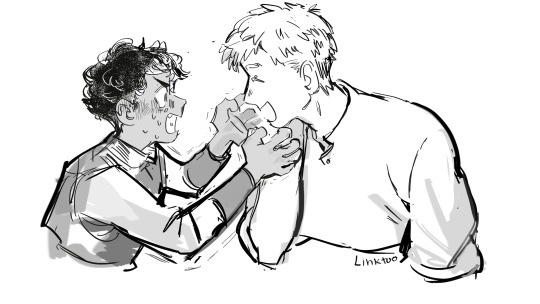
i'll strangle you or i'll kiss you on the mouth
#laius thorden#laios touden#kabru#dungeon meshi#delicious in dungeon#my art#Linktoo art#labru#narrative foil yaoi my weakness.... anyway#the way he grabs that guy and begs him to stay and begs like please LISTEN to me#its so funny how kabru‚ someone who prides himself with understanding people and their motivations#just can't handle having some random guy like laius with a big prophecy on his head remain a mystery to him#the way laius just entirely evades him it drives him crazy. kabru puts motivations and assumptions in his mouth in any attempt to Know him#hes so scared of this man yet simultaneously drawn by being unable to discern his thought process#meanwhile#laius is just autistic
10K notes
·
View notes
Text
Aspects of Thought
The intricate workings of the human mind have captivated philosophers, psychologists, and thinkers for centuries. At the heart of this exploration lies the fascinating realm of thought—a multifaceted tapestry woven from cognitive processes, experiences, and dimensions that shape our understanding of the world. Let's explore some of the various aspects of thought:
Conceptualization: Thought involves the ability to form abstract concepts and mental representations of objects, ideas, or experiences. It is the foundation for categorization, understanding relationships, and creating mental frameworks.
Reasoning and Logic: Thought encompasses the capacity for logical thinking, deductive and inductive reasoning, and problem-solving. It involves drawing conclusions from premises and evaluating the coherence of arguments.
Creativity and Imagination: Imagination is a central aspect of thought, allowing us to generate novel ideas, envision alternative scenarios, and engage in creative processes such as art, literature, and innovation.
Critical Thinking: Thought includes the ability to analyze, evaluate, and assess information and ideas critically. It involves questioning assumptions, identifying biases, and making informed judgments.
Memory and Recall: Thought encompasses the retrieval of past experiences, knowledge, and information from memory. It allows us to draw upon our stored mental database to make connections and solve problems.
Problem-Solving: Thought plays a crucial role in identifying challenges, formulating strategies, and devising solutions to overcome obstacles or achieve goals.
Language and Communication: Thought is closely linked to language, enabling us to express ideas, convey meaning, and engage in complex communication with others.
Emotional Processing: Thought involves the processing of emotions, including introspection, self-awareness, and the interpretation of emotional states.
Decision-Making: Thought guides the process of making choices among various options, considering factors such as values, goals, consequences, and ethical considerations.
Intuition and Gut Feelings: While often mysterious, thought encompasses intuitive insights and gut feelings that arise from the subconscious and inform our decisions and actions.
Metacognition: Thought includes metacognition, which is the ability to think about and monitor one's own cognitive processes, such as planning, evaluating, and reflecting on one's thoughts.
Abstraction and Generalization: Thought allows us to abstract specific instances into general principles or concepts, enabling us to apply knowledge to a wide range of situations.
Belief Formation: Thought involves the formation of beliefs, opinions, and worldviews based on evidence, experience, and personal or cultural influences.
Moral and Ethical Reflection: Thought encompasses the contemplation of moral and ethical issues, leading to the development of ethical frameworks and principles.
Dreaming and Subconscious Processing: Thought extends into the realm of dreaming and subconscious processing during sleep, contributing to memory consolidation and emotional processing.
Social and Interpersonal Thinking: Thought involves understanding and navigating social dynamics, empathy, and perspective-taking in interactions with others.
Conceptual Shifts and Paradigm Changes: Thought has the power to drive paradigm shifts and revolutions in fields of knowledge, leading to new ways of understanding the world.
The myriad aspects of thought converge to form a rich and intricate cognitive landscape, a tapestry of processes that define our humanity. From reasoning and memory to creativity and intuition, each facet adds depth and complexity to our understanding of the world. As we navigate the labyrinth of our minds, we find that it is within this tapestry of thought that our essence as thinking, feeling beings truly unfolds.
#philosophy#ontology#epistemology#metaphysics#knowledge#learning#education#chatgpt#psychology#Thought Processes#Human Cognition#Cognitive Dimensions#Creativity#Decision-Making#Critical Thinking#Memory#Emotions#Imagination#Problem-Solving#Language and Communication#Rationality#Intuition#Understanding the Mind
0 notes
Text
I am back on my bullshit again, and by bullshit I mean ADD medication, which I have been without for the past month and short of for even longer, and now I am feeling wonderful and maybe just a little above the ideal level of slightly manic
It is in this state that I ended up scribbled down some probably-esoteric notes to myself about communication and media literacy and how internal and relational meaning transforms a signal into a message
3 notes
·
View notes
Text
Intrusive Thoughts and Getting Mentally Buff
CW: Intrusive thoughts, anxiety, depression, OCD, and the intersection of them all.
Today's post was inspired by a conversation I had with a friend while streaming. They made an innocuous comment and I laughed about how it applied to my every moment.
Content Warning for discussion of Intrusive Thoughts and the ways I cope with them, along with their relation to my OCD, anxiety, and depression.
Continue reading Untitled
View On WordPress
0 notes
Text
The Mental Makeup of Fantasy's Most Feared Characters
Welcome to the dark side of epic fantasy, where the bad guys are just as interesting as the good guys.
We all know that evil, cunning, and power-hungry characters are a staple of the genre, but what exactly is going on in their heads?
Allow me to delve into the twisted minds of the most famous dark fantasy characters and try to shed some light on their motivations and thought processes. But be…

View On WordPress
#dark fantasy#epic fantasy#evil characters#fantasy characters#mental makeup#motivations#Queen Cersei Lannister#Sauron#thought processes#Voldemort
1 note
·
View note
Text
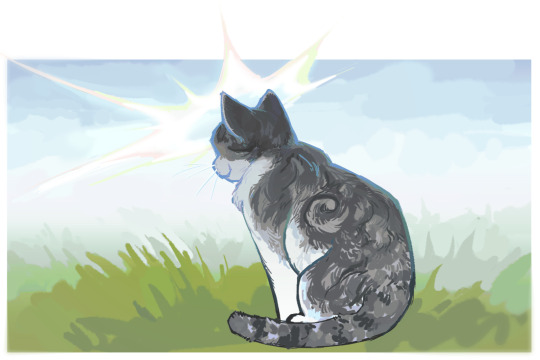
#thought drawing her will help with processing?? idk#once again. rest in peace Jellie. you were the cat ever#jellie the cat#goodtimeswithscar#mauv's work
5K notes
·
View notes
Text
hope 1/???


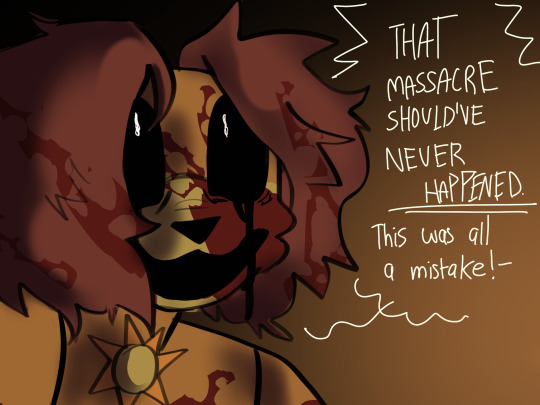
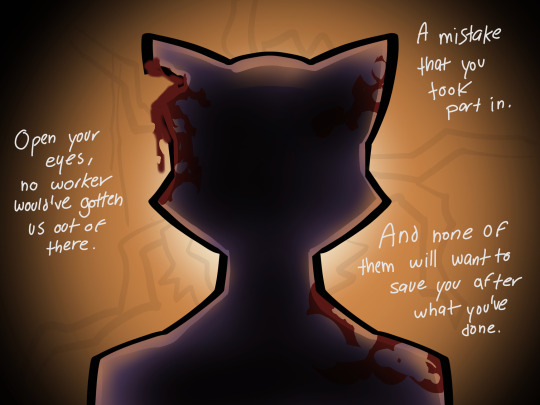


more angst!! i am actually building an au around this comic but I’ve never done aus before so like this is new to me!!!
#catnap#dogday#poppy playtime#poppy playtime 3#NOT SHIP ART!!#art#fanart#deep sleep#au#okay maybe ive tried to make an au before but it was like an undertale au with no thought process behind it i just thought the name of#the au would’ve been cool#anyways#muahahahahah#angst#maybe#comic#yeah#i always forget that one#dogday is having a bad hair day#poor guy#and catnap is just devoted man he wants freedom#who wouldnt#actually#and some of the little critters bit some of his ear off#just because#man those little things are like parasites
4K notes
·
View notes
